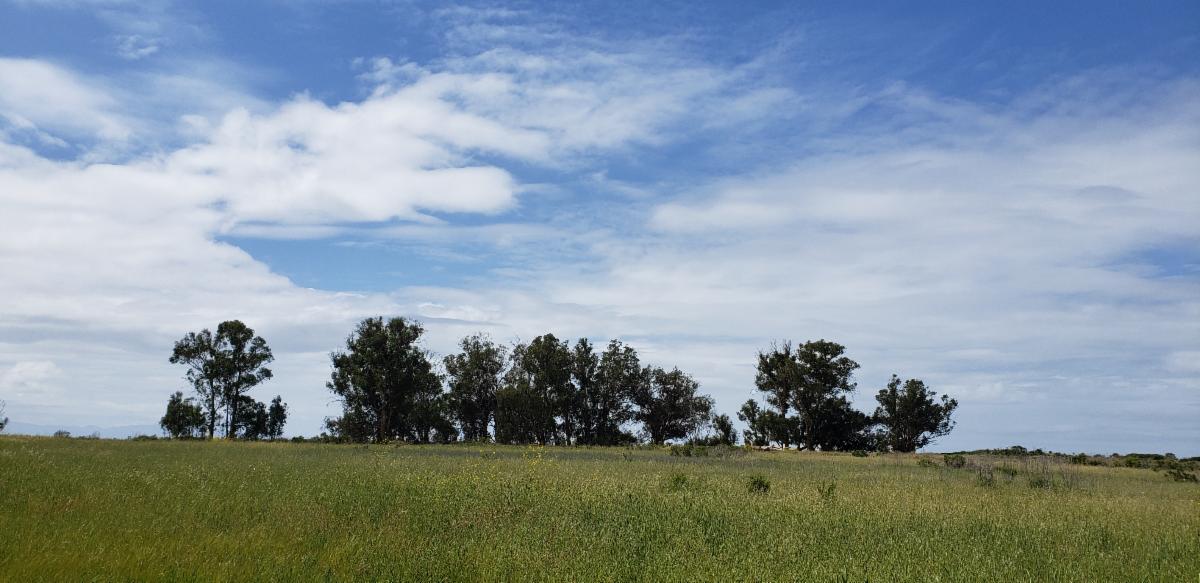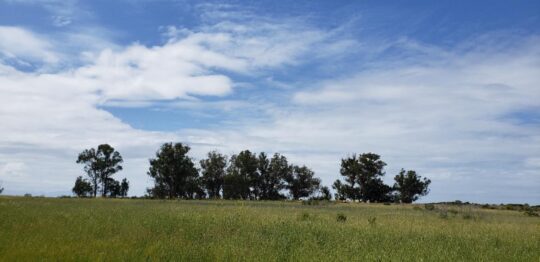
Another Christmas Present?
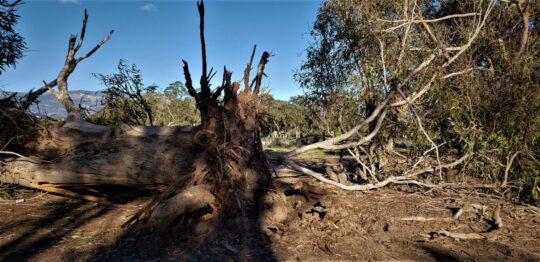
A long and event-filled Christmas day had one more surprise in store for Santa Barbara. About 9 PM, rain, and a very short “tornado-like” event whirled through a small section of Santa Barbara from Hollister Avenue to the coast. Its terrific and noisy wind caused flickering lights and, in less than a minute, it was over. Some small damage was reported in the news. But those venturing out onto More Mesa the next morning were in for a big surprise. A very large, and mostly dead, coastal eucalyptus had fallen. The debris covered large sections of two major trails, and looking at its shallow root system it was a miracle it had not fallen a long time ago!
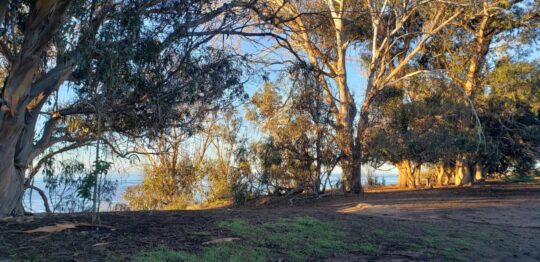
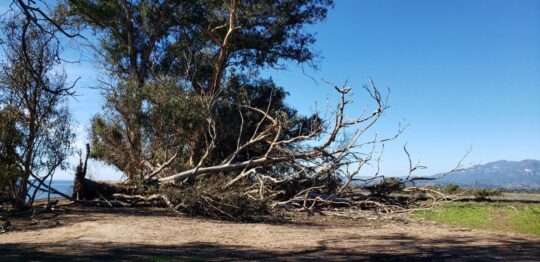
Treasure in Disguise: Branches that were dangerous were cut and the rubble carted away. Remarkably the whole scene now had tremendous potential. There were stumps and portions of the tree where one could sit and marvel at the 360°view. Talks and stories were now possible at this grand new gathering place. Youngsters also discovered that the whole area resembled a wonderful natural playground; one that was not plastic, colored purple, orange or blue, and possessed many paths to move around the various branches.
Science Too: Cuts made to arrange the tree in a stable resting position, not only created little stools, but presented an interesting and fascinating experiment. Maybe we could “read” the tree rings. If one knows how to do this you can determine not only the age of the tree, but something about the climate during the lifetime of the tree. This is a science known as “Dendrochronology”.*
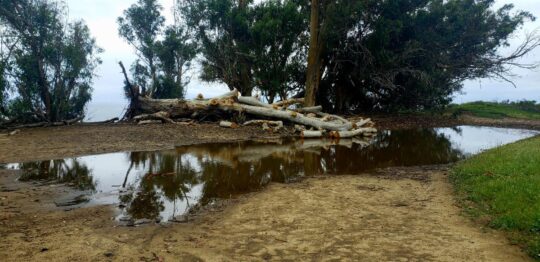
Ubiquitous Eucalyptus: Although Eucalyptus trees are everywhere in California, they are not native. Ever wonder how they got here? The answer to that question set me upon a amazing journey. The victim of the “tornado” that hit More Mesa was a Eucalyptus species commonly known as Blue Gum, “blue” because its leaves have a blue cast and “gum” because of a fragrant, sticky, gum-like substance that the tree secretes. This gum contains anti-bacterial properties which make the tree extremely pest-resistant.
How It All Started: Rarely are we able to pinpoint when an invasive species was introduced into California. This is definitely not the case for Tasmanian Blue Gum, Eucalyptus globulus. It seems that “Gold Rush” immigrants, were not happy with the look of our native forests. They wanted an ornamental and decorative tree reminiscent of the forests in their previous homelands. And they wanted it right away! There was also some concern (maybe founded, and maybe not) that firewood was growing scarce.
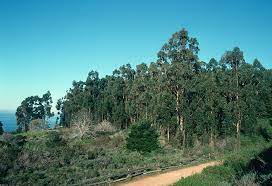
The Winner: Heeding this hue and cry, a study was commissioned in 1850, one that would suggest a suitable ornamental tree to create the desired forest. Arborists studied many different species, with the Eucalyptus subspecies known as “Tasmanian Blue Gum” finally being selected. Its lure lay in the fact that it was possibly the fastest growing tree on earth, adding 6 feet or more every year (assuming average rainfall) and had little trouble reaching 300 feet in height, even in poor soils. It not only “looked good”, but was destined to do very well in our Mediterranean climate.
Beginning of the Love-Hate Relationship: Seeds were immediately procured from Tasmania, the native habitat of Blue Gum and half a world away from the California coast. Because only seeds, and not plants, were imported, none of the tree’s enemies (pests or pathogens) came along for the ride. The Blue Gum was in heaven and everyone loved it!
The Hate Side of the Coin: Disenchantment in the populace set in by the 1880s. Although Blue Gum had been advertised for use as railroad ties, pier pilings and woodworking, none of these uses were viable, as the wood cracked and split, and poles often rotted underground. The trees were fine for windbreaks but their shallow root systems and subsequent falls soon earned them the dubious title of “widow maker”; not too comforting. The trees adapted well to foggy environments and survived with limited rainfall on the Pacific Coast. However, seeking water, they often drained nearby wells; which did not improve their popularity.
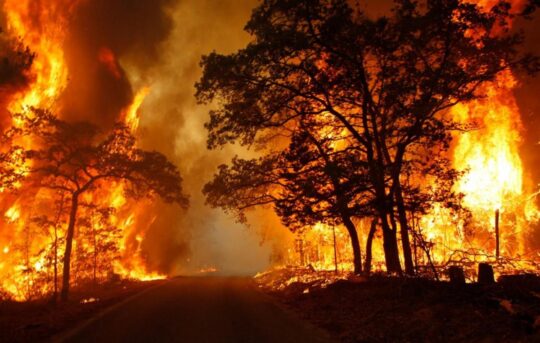
Fire also became a big issue as Blue Gum trees have the highest possible ignition potential and sometimes explode. Flames consuming the peeling bark, also move swiftly up the tree to the top, where embers are carried away to set fire to other parts of the forest.
As far as tidiness goes, the bark strips, leaves and branches that litter the floor of the eucalyptus grove are not only messy, but contain chemicals that inhibit the growth of any other plants, so Blue Gums are a monoculture, and almost always, stand alone!

The Love Side of the Relationship: If you thought the feud between the Hatfields and the McCoys was fierce and long lasting, you would be surprised by the intense Love-Hate relationship that exists with regard to the Blue Gum today. The material above pretty well describes the issues of the population that wishes the Blue Gum would disappear.
However, Blue Gum lovers have arguments for their usefulness. For example, in addition to providing windbreaks, Eucalyptus groves are wintering grounds for the Monarch Butterfly; a handy and effective switch from the native trees that were previously used … until they were chopped down for firewood or boards. Birds like Great Blue Herons, Common Egrets, Snowy Egrets, Double Breasted Cormorants and several species of Owls and Hawks use the Blue Gum for nesting. Even though these conclusions have been offered for several areas in Northern California, many argue that Eucalyptus stands do not provide an equivalent trade-off for the oak woodland and deciduous riparian environments they have replaced. Bottom line: Bird enthusiasts are really split on this issue.
There are also disputes that contend whatever replaces the Blue Gum could be an even worse fire hazard, and that the herbicides used to kill the trees would place harmful poisons into the environment.
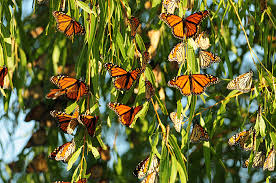
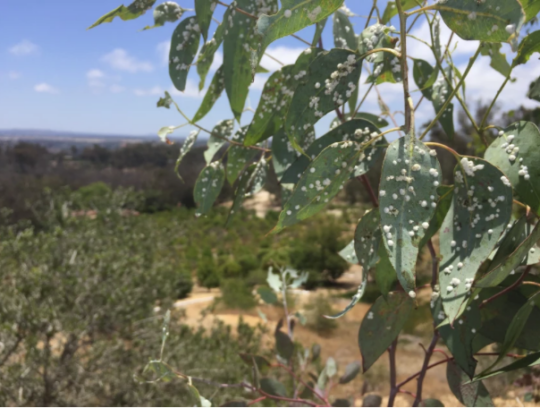
Hard Choice: Finally, lovers of Blue Gum are facing some really hard facts. That is, they have to deal with a Blue Gum nemesis. You may recall that the enemies of the Blue Gum did not immigrate to California in the 1850s. But they have finally made it here; 150 years later! Trees are being infested with an aphid-like insect that sucks out plant juices. It is called Blue Gum Lerps. The secretions of these insects are sticky and create an unsightly mess on the trees … and everything else. Lerps love it when the weather is warm and dry, so our 15-year drought is perfect for them. Needless to say, they are thriving!
With many claims and counterclaims, and not too much real science available, the Tasmanian Blue Gum issue is complicated. I personally think the data on the “love side” is well-intentioned, but relatively unsubstantiated. For starters, the issue needs an agreed upon set of facts. And finally, as one Atlantic Monthly author put it, “Until then, the magnificent Tasmanian Blue Gum is, in some sense, a prisoner of dueling realities.”
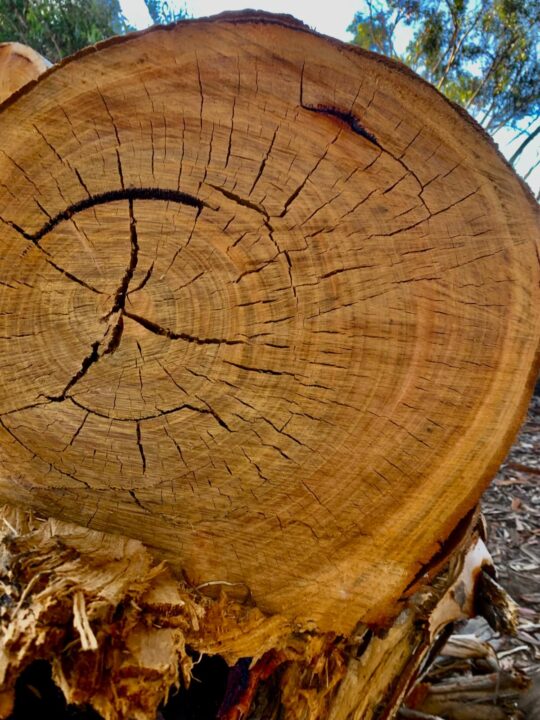
*Watch for announcements about the Dendrochronlogy Party to be scheduled. At that event, and with the help of an expert, we will attempt to age the tree and look for climate signals as well.
Our many thanks to the photographers who helped with this issue; most especially to Chris Brems.
